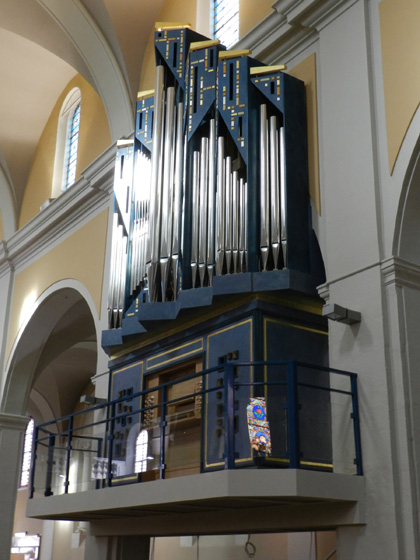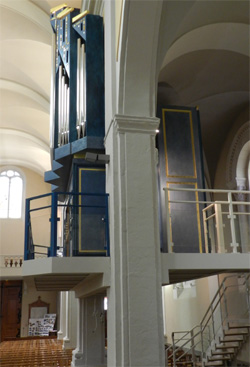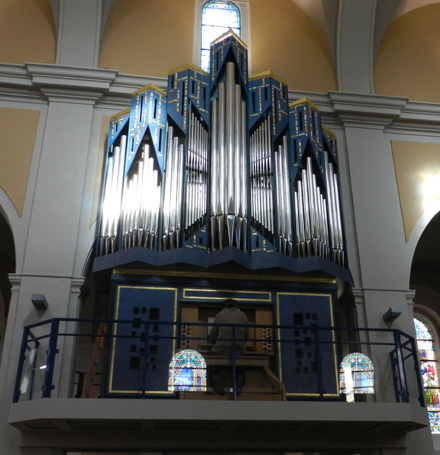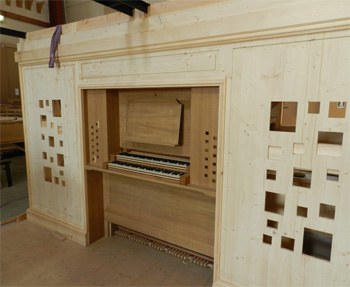

Orgue : 2 claviers , pédalier -21 jeux

Organ's description:
The situation of the instrument, on the side of the nave, at the level of the second bay, on a gallery situated at 3 meters high, allowed to arrange an organ of 22 stops distributed on two divisions, grouped on two windchests in alternated channels.
Both windchests of pedal are situated in the back in a second case, with a facade (Principal 8) in the collateral nave. This arrangement is rather common in Spain where we can see practically two organs back to back, the first one turned towards the main nave or the choir and the other one turned towards the collateral nave. It allows a good arrangement for a simple and " suspended " mechanics.
It also allowed to create a narrow instrument the visual impact of which, from a side view, is reduced at least: 0,60 meters at the level of the facade and 1,05 m at the level of the gallery. In this way, the perspective of the nave is not altered and the principle of arrangemen of the facade pipes also allows to indicate the presence of the organ from the entrance of the church.
To define the instrumental part, the " musical esthetics " itself, several aspects of the use are taken into account:
1. Use with cultural character (concerts, auditions, presentations).
2. Use on the occasion of the musical teaching.
3. Polyphonic character of the instrument
Composition :

| 1er clavier - 56 notes | Grand-Orgue - 56 notes | Pédale - 30 notes |
| Montre 8' | Bourdon 8' | Soubasse 16' |
| Dulciane 8' | Traverso 8' | Principal 8' |
| Flûte à cheminée 8' | Flûte ouverte 4' | Prestant 4' |
| Prestant 4' | Flûte 2' | Basson 16' |
| Quinte 2 2/3' | Flageolet 1' | |
| Doublette 2' | Sesqui-altera : 1 1/3'-4/5' puis 2 2/3'-3/5' | |
| Petite Quinte 1 1/3' | Trompette 8' | |
| Principal 1' | ||
| Mixture 2 rgs : 2/3' + 1/2' | ||
| Voix humaine 16' |
Shift coupler 2nd keyboard on 1st keyboard
Pedalcoupler 1er keyboard - Pedalcoupler 2nd keyboard - Tremulant
The musical project :
Without trying to serve systematically all of the musical repertoire for organ, what in this case would be difficult because of the number relatively restricted of stops, it was nevertheless planned a composition which does not limit the practice in a restrictive way. This is why we did not propose a conception " historisante", directed on a type of organs of French or German esthetics of the 17th, 18th, 19th century, but rather, a composition allowing an objective and faithful interpretation of a wide musical range. The "plenum" of the organ is, so, developed more in a polyphonic than a static way and the reed stops were built to mix with it in a complementary way.

The Polyphonic character :
Generally, the "polyphonic" qualifier is especially used about the instruments of Germanic style. It is a desired quality above all for the interpretation of the music of J.S Bach and his predecessors. However, the polyphony is not the monopoly of the German musicians. All the music of the "Renaissance" up to the first half of the 17th century, in all Europe, is essentially "polyphonic". In every country, in every region, was thus developed a polyphonic instrumental type adapted well to this type of musical writing. The case of the Italian organ is interesting : the "plenum" organized in separated rows allows a big variety of colors which adapts itself to all the forms of polyphonies.That of J.S Bach would ask for a "plenum" rather deep, on the other hand, that of Frescobaldi, require a "plenum" more clear and thus more shrill.
The arrangement which we adopted is thus directly inspired by the organization of the Italian "plenum". On the other hand, The quantity of ranks is equivalent to that of an instrument of Germanic style. The advantage lies especially in the fact of being able to decline the intensity and the color of the "plenum" what, for other types of instruments whose number of stops is reduced, is made less easy because the ranks of the "plenum" are often grouped in a single register, or eventually two.

If it exists fundamentally a difference of sound color between the various styles of organs of the same period, this one would rather be attributed to the voicing parameters of the pipes. However this point also is to be approached exactly. We say collectively, that the tone of the Italian organ is soft, quiet and bright and that it adapts itself well to a fluid polyphony with a very developed melodic character. These sound characteristics of the Italian organ are mainly those of the Italian organ of the 18th century from which the purpose was not to translate a polyphonic complex writing, quite the opposite. On the other hand, the organ of the time of Frescobaldi (17th) for the same organization of the sound material, is more incisive and more adapted to the complex polyphonic writing. The frank distinction of the styles of European organs is especially made from the second half of the 17th and in 18th century, period when the polyphonic writing, except that of J.S Bach is dying.